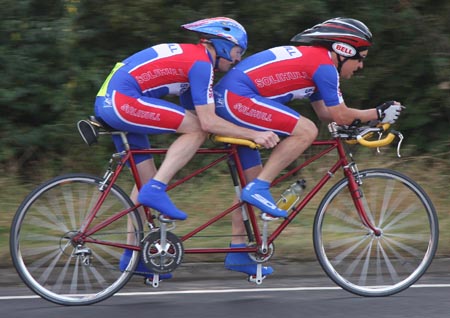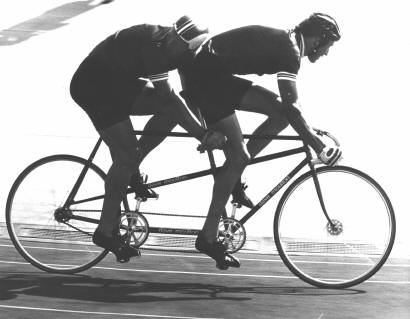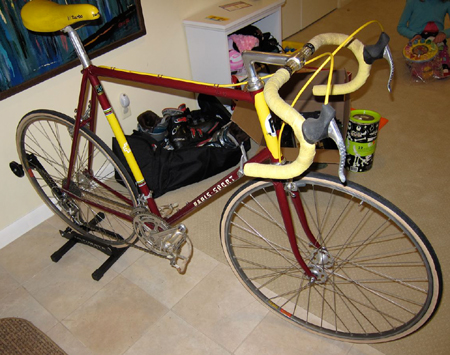Paris Sport: Setting the Record Straight
 Mon, June 20, 2022
Mon, June 20, 2022 Paris Sport was a brand name and the name of a business owned by Vic Fraysse, and his son Mike Fraysse. The business was located in Ridgefield Park, New Jersey, seven miles outside New York City, just across the George Washington Bridge.
They owned a bike store (Park Cycle.) with a framebuilding shop at the rear. On weekends the store attracted a lot of customers from New York City, who made the short bike ride via the separate bike path across the GW Bridge.
The Fraysse family had French origins and both Mike and Vic spoke fluent French. This enabled them to import bicycles and frames from France in the 1970s during the US bike boom. The bikes were labeled with the brand name, Paris Sport.
 They also had resident frame builders build high end custom frames in their shop. This was how I came to move from England in January 1979 when the Fraysse’s offered me a job.
They also had resident frame builders build high end custom frames in their shop. This was how I came to move from England in January 1979 when the Fraysse’s offered me a job.
It was much easier to move to the US in 1979 than it is today. All one needed was a job offer, and a sponsor. The Fraysse’s offered this and paid my air fare over. I arrived literally “With the clothes on my back.” My luggage consisted of the tools from my framebuilding business in England.
Mike Fraysse bought me work clothes and work boots, and I lived in the basement of Vic Fraysee’s home. Frame building materials were supplied and I was paid a flat rate per frame built.
I was satisfied with this arrangement, it got me my start in the US, and for a lot less expense and hassle than if I had I tried to set up a framebuilding business on my own.
By this time there were not too many bikes being imported from France. Because of cost the cheaper bikes sold in the bike store were imported from Taiwan. These were all labeled with the same “Paris Sport” decals, along with the high-end custom frames I was building.
Some customers felt that this cheapened the Brand, and gradually as my reputation grew, customers wanted my name on the frames I built. Vic Fraysse was strongly against this, and I had to agree with him. Paris Sport was his brand that he had worked hard for years to establish. I was simply an employee hired to build Paris Sport frames.
Mike Fraysse on the other hand was a bit more flexible. It was Mike who painted the frames, and sometimes agreed to allow my “Four M’s Logo,” to be placed on the seat tube.
 The frames were often painted in the evening after I had left for the day, so I didn’t see how the were labeled. My decals that I had brought over from England were stored in the shop along with all my tools. These were made available to Mike, and I didn’t mind either way. If a frame had my logo or name on it. It was publicity for me.
The frames were often painted in the evening after I had left for the day, so I didn’t see how the were labeled. My decals that I had brought over from England were stored in the shop along with all my tools. These were made available to Mike, and I didn’t mind either way. If a frame had my logo or name on it. It was publicity for me.
I worked at the Paris Sport shop from January 1979 until October 1980. By the mid-1980s, a few frames left the shop fully decaled as a ‘dave moulton’ but without the “worcester, england.” under the logo.
I think a lot depended on, whether the customer was a friend of Mike Fraysse, how much the customer paid for the frame, or in some cases the customer would not agree to take delivery unless it had my name on it.
After working for the Fraysse’s for almost two years, I felt I had fulfilled my obligations to them, and I left in October 1980 to take another job with Masi In California.
We parted on good terms, and I am forever grateful for the start they gave me. Had I not had this opportunity, I may never have come to the United States.
The frames I built at Paris Sport were the same as the ones I built in England. Built to my own design and geometry, with one big difference. The frames built in the UK had a serial number stamped under the bottom bracket, that coincides with a number in my UK Frame-numbers record book.
 Paris Sport frames I built had no serial number. Again, this was not my call. In fact, this is one of the clues that it is a Paris Sport frame I built. Like the one pictured here.
Paris Sport frames I built had no serial number. Again, this was not my call. In fact, this is one of the clues that it is a Paris Sport frame I built. Like the one pictured here.
The recent owner of the bike was given missinformation by its original owner. I can recognize my own work, so I am not disputing that I built it.
It apparently was labeled fully as a “dave moulton” but as it has been repainted one cannot prove that, but as I have laid out here, “It is entirely possible.” However, it is a pity the original owner did not take a picture before repainting.
Where the story gets strange, is that the original owner says he bought, and paid me directly for the frame in my own shop in New Jersey, and he has never heard of Paris Sport.
I did consult with customers, measure them and build a custom frame, but I did not handle the finances.
I am alive and well, and my memory is still intact. If you do a search on the blog, for “Paris Sport” it will bring up more history. It does not need to be re-written yet.
It is annoying to spend hundreds of hours writing here, only to have miss-informed people question what I tell them.






































Paris Sport Mystery
I never know on any given day what will show up in my email inbox, like this one from Gaelan Mundorff, who works for Eden Bicycles in Castro Valley, California. He said:
Three pictures were attached. The first I looked at was the one above showing the underside of the bottom bracket shell. No serial number, but those derailleur cable guides looked familiar, it could be my work.
Another thing that caught my eye was the “Hidden” vent holes in the Chainstay Bridge. There have to be vent holes anytime a tube is totally enclosed. I explained that in this article. The vent holes in this case were drilled though the left and right chainstays, before the bridge tube was brazed in place.
So the tube is vented through the inside of the chainstays, which are themselves open to the inside of the bottom bracket. This is something I often did, especially on custom frames. It was a good identification clue. I was thinking this was a Paris Sport frame.
The absence of a serial number was another clue. I worked for Paris Sport from January 1979 to October 1980. None of the frames I built had serial numbers. Why, I am not sure, except to say that there is no point in stamping a serial number on anything unless someone is recording those numbers in a book or file somewhere. No one seemed interested in doing that.
Paris Sport was owned by Vic Fraysee and his son Mike. The last picture (Top of page.) was a mystery to me. It showed a ‘dave moulton’ decal on the down tube. I had never seen that on a Paris Sport.
On occasions, a customer would ask to have my name on the frame as the builder rather than Paris Sport. The Fraysee’s were always adamant and said no.
I fully understood and respected this. Paris Sport was an established brand name, and I was employed to build those frames. Why would the owners of Paris Sport put the name of their employee on a frame rather than their own brand name?
Mike Fraysee had on occasions compromised and put my four “m,s” logo on the seat tube, (As this frame has.) but it always had the Paris Sport name on the down tube. And yet here was a Paris Sport frame with my name on it. Mike Fraysee painted the frames and often did so at night after I had left for the day, so I probably never saw this frame before it was shipped to the customer.
In this case the customer must have had stronger powers of persuasion than Mike Fraysee, or paid extra, or possibly refused to take delivery unless it was so labeled. Whatever the reason it is a mystery to me.
Who does all that, and then never completes the build, or rides it?That’s an even bigger mystery.